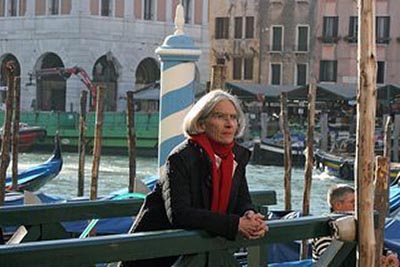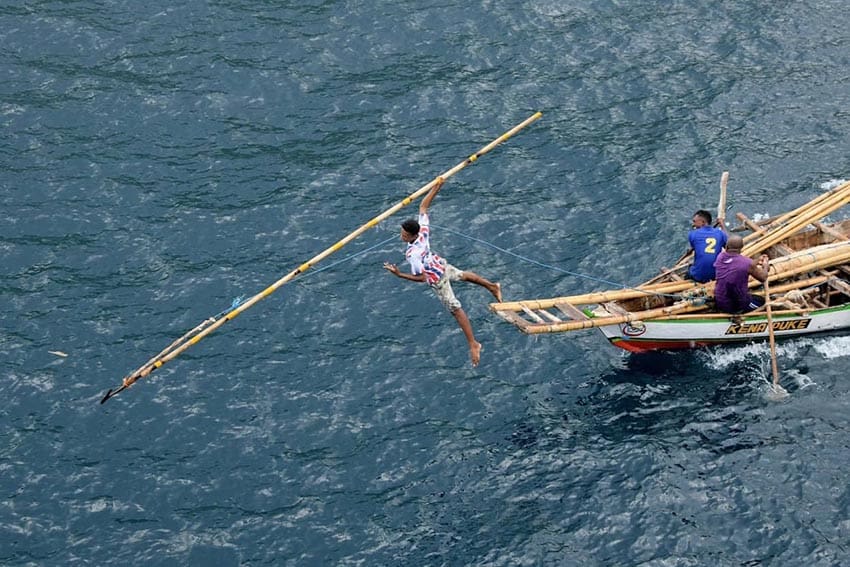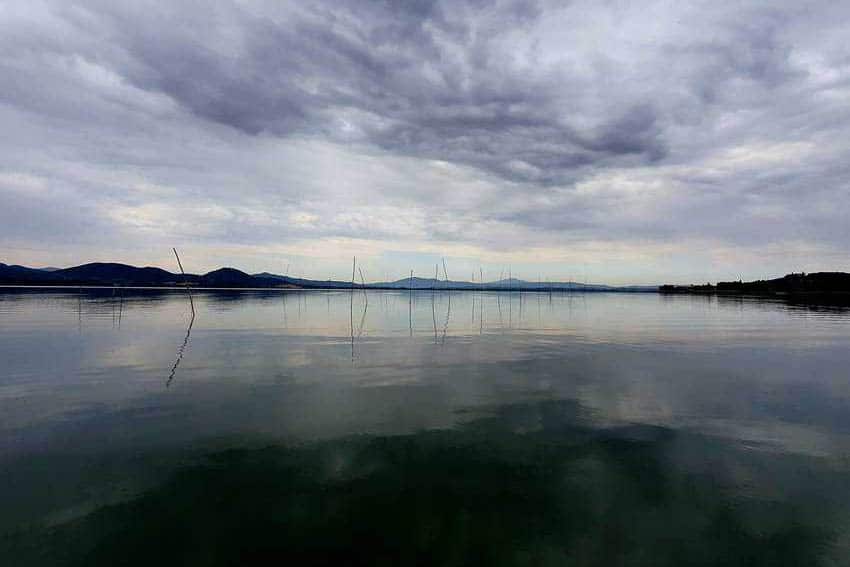
Umbria is a land of saints, monasteries, and castles. But there is more to the ‘green heart’ of Italy
By Cindy-Lou Dale
Senior Writer

On a vine-clad hill, of the Pliocene period, stands Decugnano dei Barbi, a boutique winery in Orvieto, owned by the Barbi family.
Driving through the entrance gates, you’ll sense you’re in for a treat.
The wine tour starts with a walk through the vineyards into the ancient caves, where their sparkling wine is made using the traditional method, then kept in French oak barrels.

In the tasting room, a medieval Chapel of Saint Mary of Decugnano, Maurizio Talanti talked me through their elegant produce, speaking of the marine origins of the terroir.
“The yellow sands and fossil oyster shells provide testimony that this was once nothing more than a seabed of the Pliocene era.
The vineyards have their roots in the sandy and clayey land, among oyster shell fossils, giving the grapes mineral and marine characteristics,” Maurizio said.
Heading to the lake
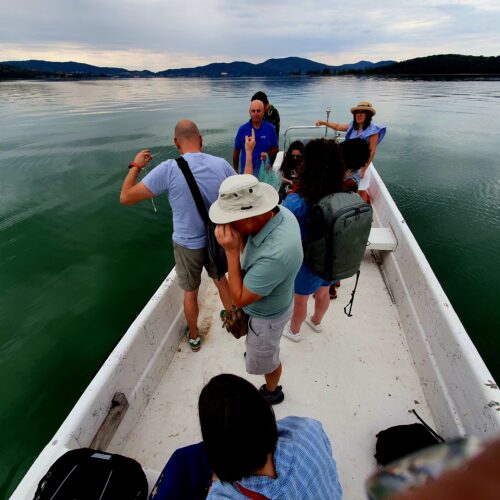
Take a drive to the village of San Feliciano, on Lake Trasimeno – Italy’s oldest lake. Here professional fishing has been the principal income earner of the locals for centuries.
Here I met Aurelio Cocchini, of the Trasimeno Fishermen Cooperative (one of the largest organized fishing communities in inland waters). He spoke at length about preserving the profession of lake fishermen.
Made up of a workforce of at least fifty people, the co-operative defines itself as the guardian of Lake Trasimeno – a fragile but magical ecosystem in which the fishing partners live in perfect harmony, protecting the balance through fully sustainable fishing.
As if on cue, a co-operative member delivered his day’s catch to the warehouse, where it was weighed then further processed, guaranteeing a steady supply of fresh fish to the local tourism-hospitality sector.

Promoting Awareness
Working to promote awareness of the local fish and territory through ‘fish-tourism’, gives visitors the opportunity to find out what it means to be a fisherman – even if it’s only for one day.
The co-operatives fishing excursions have fishermen demonstrate and teach them traditional net techniques.
Once the nets have been positioned, and allowing time for the fish to get comfortable around the near invisible nets, Aurelio suggested a visit to the nearby island of Polvese (a nature reserve) and lunch at Impact Zero Beach Bar.
On the later return from Polvese, the nets were slowly pulled up, but the jaw-dropping sunset demanded everyone’s attention.
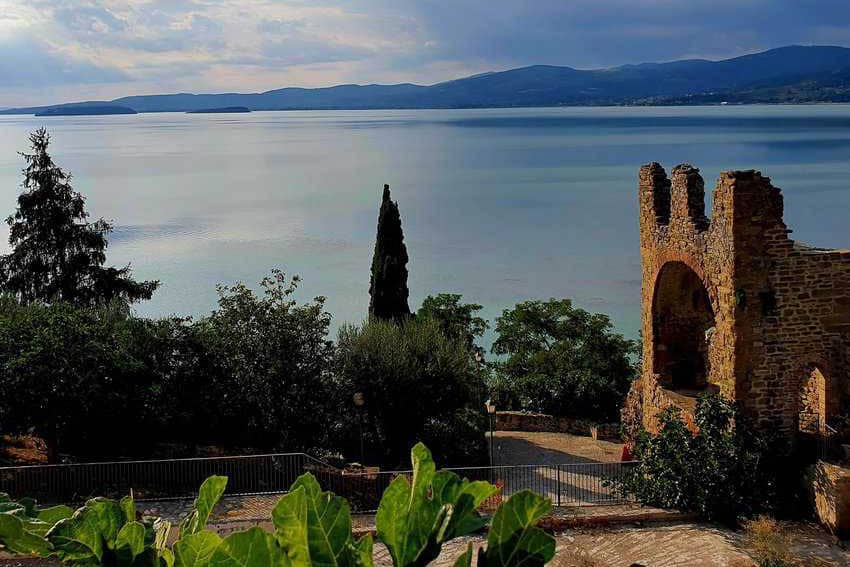
An olive oil tasting

On the eastern shores of Lake Trasimeno is the 14th century village of Monte del Lago. Here the occasion is an olive oil tasting.
Set between the walls of the village, overlooking the lake, and surrounded by olive groves, is the HQ of Fattoria Luca Palombaro.
For almost a century, Luca Palombaro and his ancestors, have been producing olive oil on the 200-hectare farm that extends along the hills surrounding Lake Trasimeno.
The tasting takes place in a building that is the result of renovation work carried out by its historic owners over the years.
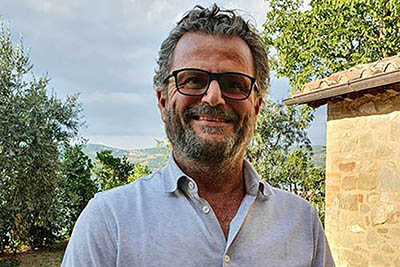
Sitting on a terrace, Luca presents two types of olive oil: the delicate, velvety ‘Belfiore’ produced only with the variety of olive trees typical of Lake Trasimeno, and the ‘Roncone’ – a robust fruity blend.
“With our olives,” Luca said, “we only produce extra-virgin olive oil. At the time of harvesting, the fruit is carefully hand selected.
This care means that every olive-oil season tells the story of the uniqueness of the year’s production, but at the same time retains our production philosophy and high quality of our oil.
“Our olive groves, which are immersed in unspoiled nature, among woods and meadows, enjoy the sunsets of Lake Trasimeno every day – and that is how harmony and purity become flavor and scent.”
Today Luca manages the Estate and its link with tradition. New technology may well produce efficient production methods, but the traditional way will always be the point of reference.
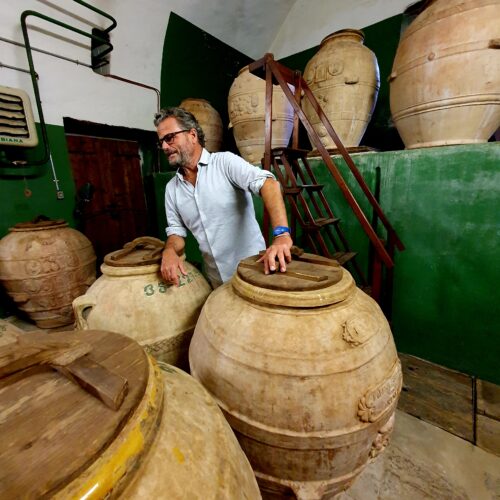
This was demonstrated when he showed me into the ancient Ziraia – a room housing enormous, centuries-old, olive oil storage jars, the stone millstones, and the ancient presses.
Eat in Umbria:
Dinner is at Da Lidia in the historic Relais la Fattoria, found in the ancient mountain village of Castel Rigone (543AD). It sits on an extreme buttress of the Central Apennines mountains, some 650 meters above sea level, with magnificent views across Lake Trasimeno.
Dine on the terrace and expect typical Umbrian cuisine. It’s all created in the traditional way, including the homemade pasta. But it’s all about the Panna Cotta Fantasia. So, eat the dessert first. Life is short and unpredictable.
Sleep in Umbria:
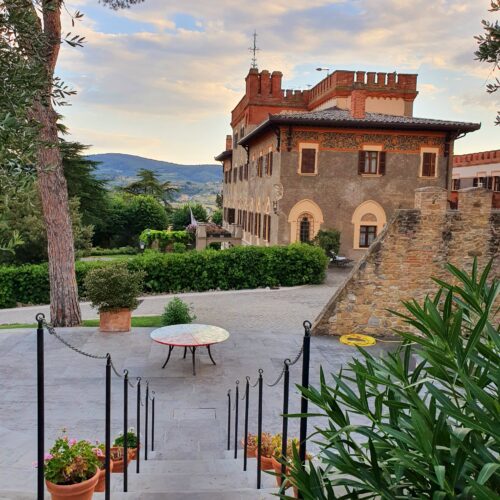
Borgo dei Conti in Montepetriolo (a few kilometers from Perugia), has a long driveway that leads to the elegant resort.
This historic 50-room hotel, part of the Relais & Chateaux group, is widespread and set in a 20-hectare ancient pine forest. Inside the Italian Middle Ages and subsequent eras have left an indelible mark, yet sits comfortably alongside 21st century mod cons.
In addition to the superb setting and accommodations is another restaurant (which overlooks the infinity pool), a jacuzzi, Technogym machines, two saunas, a Turkish bath, and the two emotional chrome showers.
Dining on the terrace under giant pines, is heavenly. Expect waves of gourmet delight.
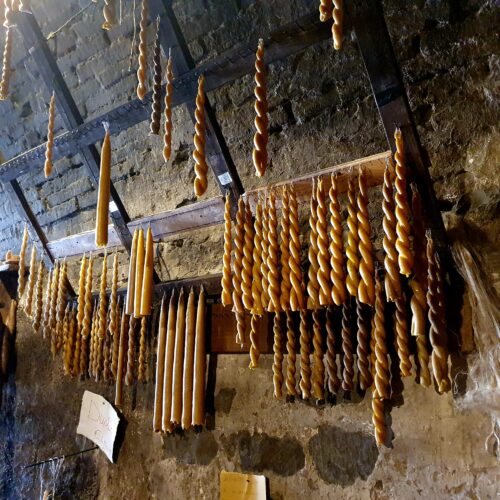
Arts & Crafts of Umbria
The village of Bevagna is a member of the Most Beautiful Towns of Italy club for its environmental, cultural and artistic heritage. The town, whose medieval urban layout remains intact, is surrounded by ancient walls, with towers and gates.
The Cultural Circuit of Bevagna’s Medieval Crafts is fascinating. Here masters of the art and expert craftsmen demonstrate the medieval crafts, using ancient production methods in creating of cotton paper derived from rags, beeswax candles dissolved in boilers then twisted into a ‘duplero’, medieval painting techniques, and silk fabrics from breeding silkworms used in weaving the precious thread on 15th century looms.
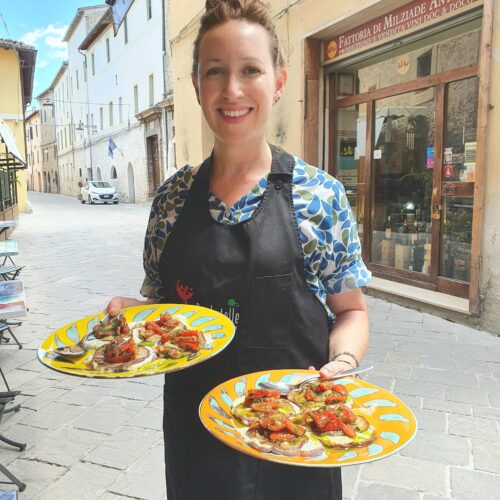
Dining in Bevagna
There is only one true way to get to know a region’s food, and that’s to go there, and eat the food among the people who consume it every day.
That way it’s seasoned with a sense of the place, the landscape, the culture, and traditions. And this is what you’ll find at Le Barbatelle, an intimate two-level restaurant with outdoor tables all year round.
On the menu are only the best local, artisanal, and seasonal produce of the area, paired with natural and organic wines.
Iconic American chef, Jennifer McIlvaine brings something else to the plate besides food – her own formula is about the art, the music, the place, the ingredients.
It’s the whole concept behind her food that makes it far more interesting. And it’s all made with centuries of traditional ingredients but used in a different way. Taking memories of food and interpreting them in a modern way.
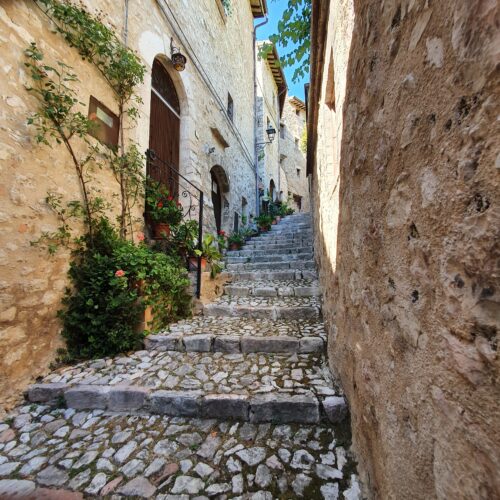
The fairy-tale village of Scheggino
The next stop is Scheggino, a 13th century triangular-shaped hillside village, with around 450 inhabitants.
To me, Scheggino is the prettiest village in all of Italy. I walked the narrow medieval cobbled streets and climbed the many steps, agog at such a concentration of fairy-tale perfection.
It’s surrounded by nature, and at every corner is a view more splendid than the last. I never once saw a home (each perfectly preserved) I wouldn’t want to live in, or a view I wouldn’t want to call my own.
It is hard to accept that it’s real, and people come home to these stone houses every night, and walk their dogs here, going through life thinking that this is the way of the world.
Dining at Borgo 209
At the foot on Scheggino is Borgo 209. Think central heating for the soul, rustic staples, full of honesty and freshness, laced with shavings of truffles. It’s the farm to fork gift of nature.
The raw produce comes from places that haven’t been messed about with, so it remains unspoiled. The rest is the power of chef, Gloria Moretti. Her generosity of spirits is never ending.
Lodgings
Where would you hide a spa hotel in such a tiny treasure chest, I wondered. Obviously, in plain sight. The smart-thinking development of the Torre Del Nera, a scattered hotel, consists of 16 historic houses located along the 12th century wall and 12 rooms located in the ancient Fortress of the Knights.
Like the village itself, each room is perfectly dressed, and comes with all the requirements of 21st century living.
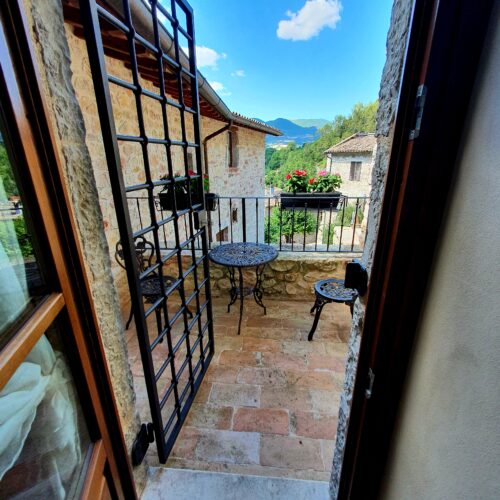
You’d be hard pressed to find a better room than mine – No 27, with two balconies, a kitchenette and forever views.
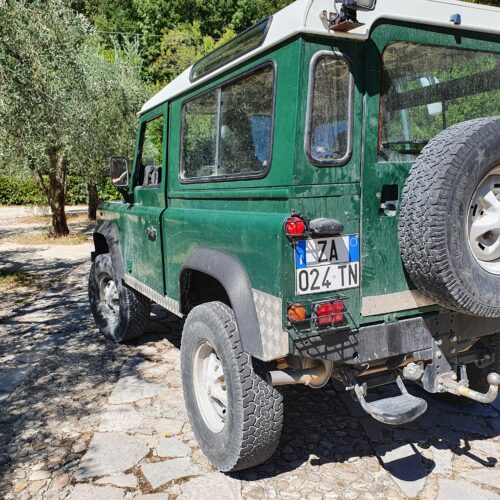
Umbria Truffle hunting
Driving past the majestic Marmore Falls, I’m heading to the village of Ferentillo. The destination is Piermarini, a family-owned restaurant. At first, I thought it to be a hotel with its large expanse of lush, manicured lawns, oak trees, and swimming pool.
Pier Marco Piermarini piles a small group of people into his old Land Rover and bounces off to his family’s truffle farm on a nearby hill.
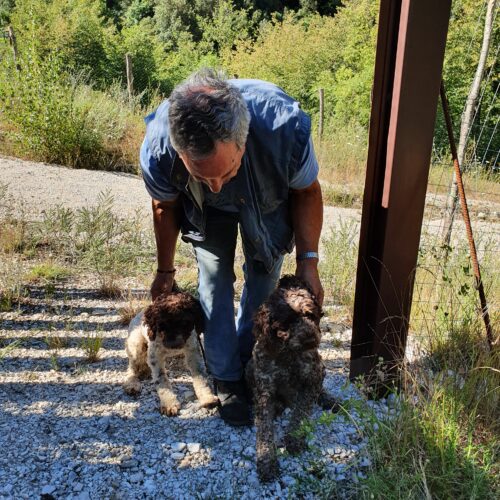
Truffle hunting is an emotional encounter with a slow-paced man and his dog. In his jacket pocket he’s carrying a small truffle spade (vanghini). Suddenly there is a joyous tail wagging. The hunter pulls the dog back from where his nose is sniffing at the soil.
His little spade digs into the earth in the exact spot where the dog’s nose was, and the hunter unearths a bulbous fungus, a delicious form of mushroom that grows underground near the roots of broadleaf trees.
The hunter is holding a rotund black clump of earth in his hand – it looks rough, with a granular exterior. As he steps closer, the truffle permeates a pungent, distinctly earthy aroma.
Unearthed Truffles in the Kitchen

Back at the Piermarni Restaurant, I’m standing around in their massive stainless-steel kitchen. Chefs are preparing numerous courses of foods containing the just unearthed truffles.
The ingredients all natural, all local, and all handmade, celebrate traditional flavors, with an added chefy creative flair.
“In this kitchen, we use produce from our territory that we’ve researched and selected with care, to guarantee the genuineness and quality of every single ingredient,” says owner, Primo Piermarini. Expect way more than lunch. This is a food experience extraordinaire.
Let there be music

The Narnia Festival, held in July each year, is one of the greatest festivals in Italy – if not all of Europe – of art, music, and culture, with performances by world-famous artists, exhibitions, cultural activities, and the best of teaching at an international level.
I was honored to be in a small audience, witnessing a preview performance by the beautiful Cristiana Pegoraro, a world-acclaimed pianist who has studied at the Conservatory of Terni (her hometown), in Vienna, Salzburg, Berlin, and more recently at the Manhattan School of Music in New York City.
I’m more of a rock chick, so it took me a minute or two to get into the groove when Cristiana played a few classics.
But it all changed when she keyed her own compositions. Her interpretations and skill are spellbinding.
One piece in particular, ‘The Wind & the Sea’, she described as one of childhood memories, watching the sea and wind at play, and how the sea mourns when the wind is not there.
This is an emotive artist of the highest calibre. You can hear and see, in your mind’s eye, exactly what she, as a child, had sight of. I was moved to tears, as was everyone else in the room.
Reflections on Umbria
Umbria is a mass of pastoral villages and tall mountains, timeless and fetching landscapes, rooted to an ancient past.
In small towns and villages, life is slow. Stroll past small delis with their shuttered windows standing open, displaying hocks of ham and wheels of cheese; sidewalk cafes where locals sit almost motionless with their newspapers and little espressos.
It’s about the food, those who grow it, and the hands that prepare it. Leave Milan to Armani, Modena its supercar factories, Venice its canals, and let Rome have its art, and hordes of visitors.
Where you want to be is camera-shy Umbria.
- African Wildlife Safari and Zambezi Riverboat Cruise - October 30, 2024
- Taste of Ethiopia: a Food Tour of Addis Ababa - October 10, 2024
- The Elephant Camp, Victoria Falls, Zimbabwe - October 3, 2024




